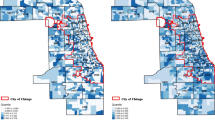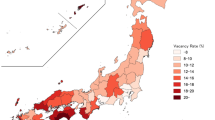Abstract
By splitting the spatial effects into building and neighborhood effects, this paper develops a two order spatio-temporal autoregressive model to deal with both the spatio-temporal autocorrelations and the heteroscedasticity problem arising from the nature of multi-unit residential real estate data. The empirical results based on 54,282 condominium transactions in Singapore between 1990 and 1999 show that in the multi-unit residential market, a two order spatio-temporal autoregressive model incorporates more spatial information into the model, thus outperforming the models originally developed in the market for single-family homes. This implies that the specification of a spatio-temporal model should consider the physical market structure as it affects the spatial process. It is found that the Bayesian estimation method can produce more robust coefficients by efficiently detecting and correcting heteroscedasticity, indicating that the Bayesian estimation method is more suitable for estimating a real estate hedonic model than the conventional OLS estimation. It is also found that there is a trade off between the heteroscedastic robustness and the incorporation of spatial information into the model estimation. The model is then used to construct building-specific price indices. The results show that the price indices for different condominiums and the buildings within a condominium do behave differently, especially when compared with the aggregate market indices.
Similar content being viewed by others
References
Arnold, S. F. (1993). “Gibbs Sampling”. In C.R. Rao (ed.), Computational Statistics. Amsterdam, NY: North Holland, pp. 599–626.
Bardhan, A. D., R. Datta, R. H. Edelstein, and S. K. Lum. (2003). “A Tale of Two Sectors: Upward Mobility and the Private Housing Market in Singapore,” Journal of Housing Economics 12(2), 83–105.
Basu, S., and T. G. Thibodeau. (1998). “Analysis of Spatial Autocorrelation in House Prices,” Journal of Real Estate Finance and Economics 17(1), 61–85.
Brunsdon, C., A. S. Fotheringham, and M. E. Charlton. (1996). “Geographically Weighted Regression: A Method for Exploring Spatial Nonstationarity,” Geographical Analysis 28, 281–298.
Can, A., and I. Megbolugbe. (1997). “Spatial Dependence and House Price Index Construction”, Journal of Real Estate Finance and Economics 14, 203–222.
Case, K. E., and R. J. Shiller. (1989). “The Efficiency of the Market for Single-family Homes,” American Economic Review 79(1), 125–137.
Casetti, E., and J. Poon. (1995). “Econometric Models and Spatial Parametric Instability: Relevant Concepts and an Instability Index”. In L. Anselin, and R. J. G. M. Florax (eds.), New Directions in Spatial Econometrics, New York: Springer, pp. 200–224.
Dubin, R. (1988). “Estimation of Regression Coefficients in the Presence of Spatially Autocorrelated Error Terms,” Review of Economics and Statistics 70, 466–474.
Dubin, R. A. (1992). “Spatial Autoregression and Neighborhood Quality,” Regional Science and Urban Economics 22, 433–452.
Dubin, R. A. (1998). “Spatial Autocorrelation: A Premier,” Journal of Housing Economics 7, 304–327.
Dubin, R. A., R. K. Pace, and T. G. Thibodeau. (1999). “Spatial Autoregression Techniques for Real Estate Data,” Journal of Real Estate Literature 7, 79–95.
Gelfand, A. E., and F. M. Smith. (1990). “Sample Based Approaches to Calculating Marginal Densities,” Journal of American Statistical Association 85, 398–409.
Gelfand, A.E., S. K. Ghosh, J. R. Knight, and C. F. Sirmans. (1998). “Spatio-Temporal Modeling of Residential Sales Data,” Journal of Business and Economics Statistics 16, 312–321.
Gelfand A. E., M. D. Ecker, J. R. Knight, and C. F. Sirmans. (2001). “The Dynamics of Location in Home Prices,” Working Paper, University of Connecticut.
Gelfand, A.E., H. Kim, C. F. Sirmans, and S. Banerjee. (2003). “Spatial Modeling with Spatially Varying Coefficients Processes,” Journal of the American Statistical Association 98(462), 387–396.
Geman, S., and D. Geman. (1984). “Stochastic Relaxations, Gibbs Distributions and the Bayesian Restoration of Images,” IEEE Transactions on Pattern Analysis and Machine Intelligence 6(6), 721–741.
Geweke, J. (1993). “Bayesian Treatment of the Independent Student Linear Model,” Journal of Applied Econometrics 8, 19–40.
Gillen, K., T. G. Thibodeau, and S. Wachter. (2001). “Anisotropic Autocorrelation in Housing Prices,” Journal of Real Estate Finance and Economics 23(1), 5–30.
Hwang, M., and J. Quigley. (2004). “Price Discovery In Time and Space: the Course of Condominium Prices in Singapore”. Working paper. National University of Singapore.
Kenkel, J. (1996). Introductory Statistics for Management and Economics. New York: Duxbury Press.
LeSage, J. (1999). “The Theory and Practice of Spatial Econometrics,” (Manuscript).
McMillen, P. D. (1996). “One Hundred Fifty Years of Land Values in Chicago: A Nonparametric Approach,” Journal of Urban Economics 40(1), 100–124.
McMillen, P. D., and J. F. McDonald, (1997). “A Nonparametric Analysis of Employment Density in a Polycentric City,” Journal of Regional Science 37, 591–612.
Olmo, J. C. (1995). “Spatial Estimation of Housing Prices and Locational Rents,” Urban Studies 32(8), 1331–1344.
Ong, S. E., and Y. C. Koh, (2000). “Time-on-Market and Price Trade-offs in High Rise Housing Submarkets,” Urban Studies 37(11), 2057–2073.
Ong, S. E., and T. F. Sing, (2002). “Price Discovery between Private and Public Housing markets,” Urban Studies 39(1), 57–67.
Pace, R. K., and O. W. Gilley. (1998). “Generalizing the Grid and OLS Estimators,” Real Estate Economics 26, 331–347.
Pace, R.K., R. Barry, and C. F. Sirmans. (1998a). “Spatial Statistics and Real Estate,” Journal of Real Estate Finance and Economics 17(1), 5–13.
Pace, R.K., R. Barry, J. M. Clapp, and M. Rodriquez. (1998b). “Spatiotemporal Autoregressive Models of Neighborhood Effects,” Journal of Real Estate Finance and Economics 17(1), 14–33.
Pace, R. K., R. Barry, O. W. Gilley, and C. F. Sirmans. (2000). “A Method for Spatial-temporal Forecasting with an Application to Real Estate Prices,” International Journal of Forecasting 16, 229–246.
Author information
Authors and Affiliations
Corresponding author
Rights and permissions
About this article
Cite this article
Sun, H., Tu, Y. & Yu, SM. A Spatio-Temporal Autoregressive Model for Multi-Unit Residential Market Analysis*. J Real Estate Finan Econ 31, 155–187 (2005). https://doi.org/10.1007/s11146-005-1370-0
Published:
Issue Date:
DOI: https://doi.org/10.1007/s11146-005-1370-0




